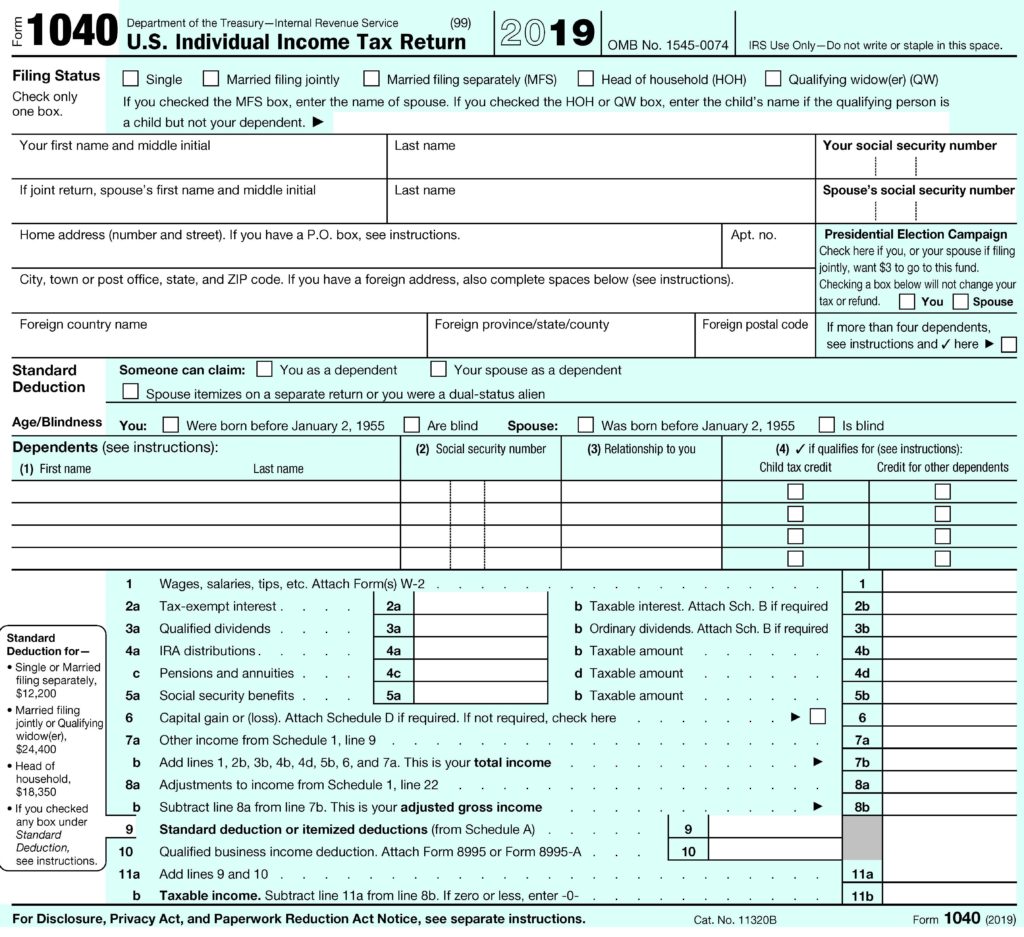
2019 Tax Law Changes
Businesses
1. Schedule C-EZ Obsolete
Schedule C-EZ is the simplified version of IRS Schedule C, Profit or Loss from Business (Sole Proprietorship). For 2019, the IRS has discontinued Schedule C-EZ, so the long form most be used by all.
Employees
1. Social Security wage ceiling
The maximum amount of earned income on which you pay Social Security tax is now $132,900. When you reach that amount with one employer, they should stop withholding Social Security tax from your pay until the following year. If you work for more than one employer, and your total earnings are more than $132,900, TaxAct calculates a credit for any overpayment of Social Security taxes.
2. Foreign earned income exclusion
If you qualify, you can exclude up to $105,900 of your foreign earned income from your taxable income for 2018. If you and your spouse both work in separate foreign countries and meet the qualifications, you may each be able to exclude up to $105,900.
Families
1. Child Tax Credit
The child tax credit remains $2,000 per qualifying child. Phase out also remains steady at $200,000 ($400,000 if married filing jointly). Qualifying children must have a Social Security Number (SSN). If a child has an ITIN but no SSN you may be able to claim the Other Dependent Credit instead.
2. Credit for Other Dependents
This credit, new last year, allows you to claim a credit of up to $500 for a dependent who does not qualify for the child tax credit. A qualifying relative may be considered a dependent for this credit.
Homeowners
1. Disaster Tax Relief
If you were one of the many Americans affected by hurricanes or wildfires in 2019, the IRS may be able to help. Visit the IRS Guidance for Those Affected by Disasters page to see if you qualify.
2. Moving Expenses
If you move in 2019, you are no longer able to deduct moving expenses unless you are an active military member and were ordered to move.
3. Mortgage Interest Deduction
You can still deduct mortgage interest in many cases, but new law changes impose stricter limitations. The new cap for qualified residence loans is $750,000 ($375,000 if married filing separate). This total can only include funds used to buy, build, or substantially improve a qualifying residence.
Everyone
1. Qualified Opportunity Zone deduction (Form 8997)
If you invest in property in a designated qualified opportunity zone, you may be able to defer gains on that investment by filing Form 8997. This may apply to individuals, C corporations, S corporations, trusts, and estates. The IRS defines a qualified opportunity zone as a population tract that is a low-income community designated as a qualified opportunity zone. A list of qualified opportunity zones can be found on IRS Notice 2018-48 and Notice 2019-42.
2. Standard deduction
The standard amount you can deduct from income if you don’t itemize your deductions is $12,200 ($24,400 for married couples filing jointly, or $18,350 if you file as head of household).
3. Alternative Minimum Tax
The Alternative Minimum Tax (AMT) exemption amount for individuals rises in 2019 to $71,700 and begins to phase out at $510,300. For married couples filing jointly, the exemption rises to ($111,700, with phase-out beginning at $1,020,600 for married couples filing jointly).
4. Earned Income Credit
If you have no children, your maximum Earned Income Credit for 2019 is $529. With two children, the maximum amount is $5,787, and with one child, it is $3,526. If you have three or more qualifying children, the maximum Credit you can receive for 2019 is $6,557 (up from $6,431 in 2018).
Education & College
1. American Opportunity Tax Credit
The American Opportunity Tax Credit income limits remain unchanged for 2019. You can claim this benefit even if the student doesn’t receive Form 1098-T from the education institution. Make sure to have your TIN ready by the time you file – you can’t claim the credit without it.
2. Lifetime Learning Credit
The income limits increase this year to $68,000 ($136,000 if married filing jointly).
Healthcare
1. Individual Shared Responsibility Provision
This mandate expired December 31, 2018.
High-income households
1. Limitation on itemized deductions
The Pease provision that outlined limits on itemized deductions for high-income households has been eliminated for 2018.
2. Personal exemption phase-out (PEP)
Since the Tax Cuts and Jobs Act removed personal exemptions, the phase-outs are gone as well.
3. Death tax rate
For persons who died in 2019, the federal estate tax rate remains at 40%. This tax only applies to estates larger than $11,400,000.
Miscellaneous
1. Standard mileage
The standard mileage rate for the use of your car or other vehicle jumps to 58 cents per mile for business (up from 54.5 cents for 2018) and up to 20 cents per mile driven for medical or moving purposes (up from 18 cents for 2018). The rate for charitable travel remained the same at 14 cents per mile.
2. Contribution limits for flexible spending accounts
The most you can contribute to one of these plans increases to $2,700. Your spouse can also contribute $2,700 if he or she meets the qualifications. For certain FSAs, up to $500 can still be carried over to the next year.
3. Medical Savings Accounts
(1) Self-only coverage. The term “high deductible health plan” as defined in Sec. 220(c)(2)(A) means, for self-only coverage, a health plan that has an annual deductible that is not less than $1,350 and not more than $3,500, and under which the annual out-of-pocket expenses required to be paid (other than for premiums) for covered benefits do not exceed $6,650.
(2) Family coverage. The term “high deductible health plan” means, for family coverage, a health plan that has an annual deductible that is not less than $2,700 and not more than $7,000, and under which the annual out-of-pocket expenses required to be paid (other than for premiums) for covered benefits do not exceed $13,500.
(Source : Taxact.com – https://www.taxact.com/reference/library-index)
